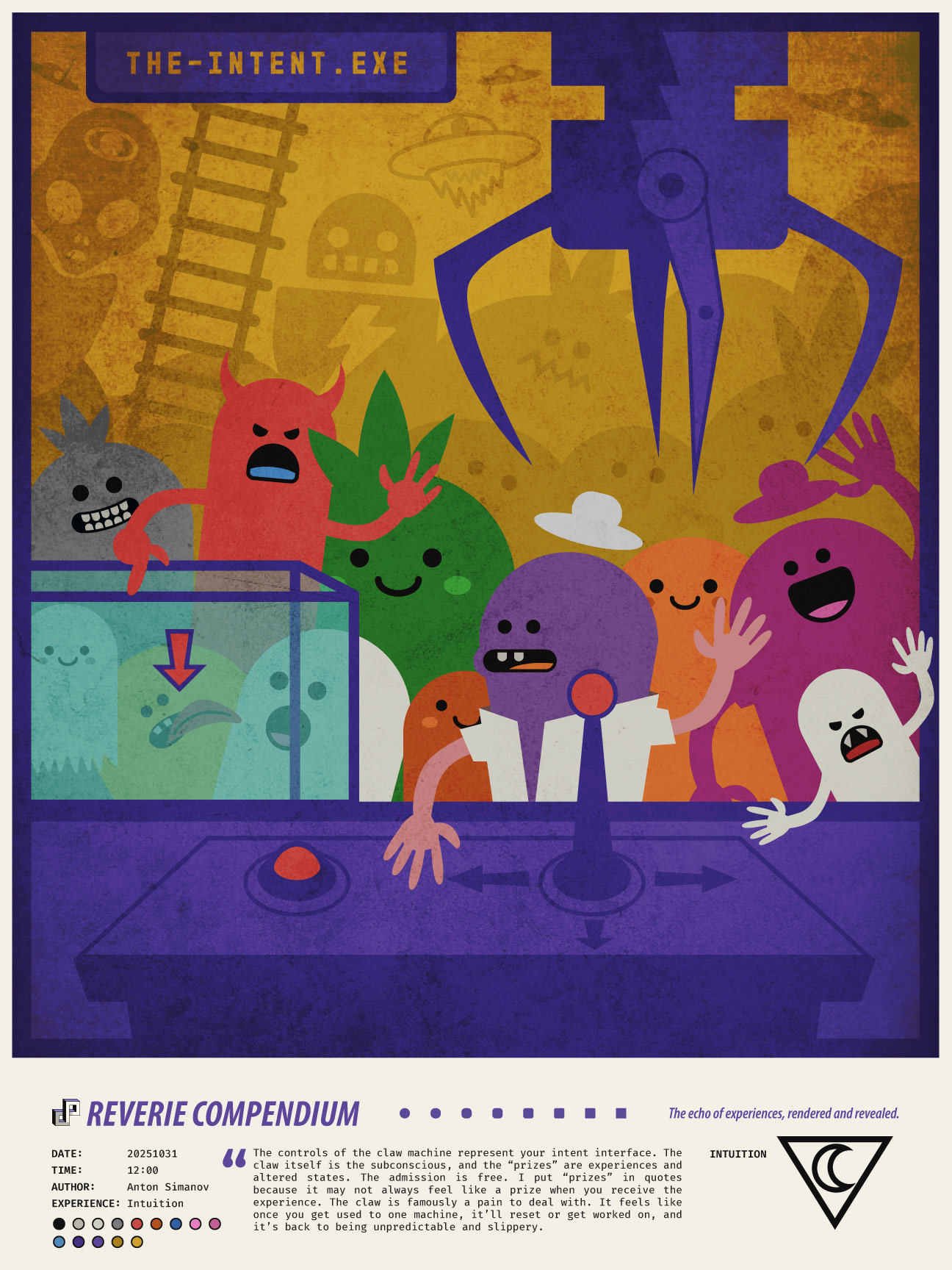The Claw Machine of Intent
Pretty busy today and not a lot of time to meditate, so I used whatever little time I had to begin practicing and strengthening my understanding and process of setting intent. I was moderately tired after having lunch, and since I didn’t have much time, I decided to simply settle on a quick nap.
Before I got started, I set one clear and concise intent: “When my body sleeps, I remain aware.” After about five minutes of putting whatever emotion I could into charging up the intent, I lay down and visualized “When my body sleeps, I remain aware” to the best of my abilities. Finally, I promptly fell asleep and nothing happened. When I woke up after this brief nap, I chuckled and decided that I was simply too tired for anything to occur.
Intent
From my own experience and others’ accounts, intent is, I hate to say it, just like anything related to consciousness: slippery as all heck. Most of the time, it requires several repetitions of the intent over a few weeks to see results as the subconscious learns the command and what exactly it is that you want to achieve. In fact, most techniques and programs emphasize this aspect pretty early on. While I fully understand and am familiar with the mechanics of intent -> subconscious -> experience, I’m nonetheless on the hunt to speed up this recognition of “instructions for the subconscious.”
Why am I doing this? The majority of how or when altered states happen isn’t exactly dependable. There are various factors involved in the entire process, of course, but the main driver and interface that we all have to achieve these states and others is intent.
Intent Model
The model I like to use isn’t unique. It’s quite old, actually, but in a nutshell:
- Subconsciousness is like the kernel; it has all the permissions and access to everything.
- That would make things like altered states “applications.”
- Intent is the “command line prompt,” and the terminal is always in admin mode. You just need to know exactly what you want and not hesitate about it.
The language of symbols, emotion, and repetition is the syntax your subconscious uses. It doesn’t process linguistic logic; it runs on imagery, feeling, and certainty. Emotion is what flags an intent as executable code. Without it, it’s just a comment line. The subconscious understands metaphors better than syntax. If you visualize vividly (or feel-sense vividly), it interprets that as an instruction. The kernel doesn’t act on a one-off input. It acts on a pattern: rituals, mantras, or nightly affirmations as ways of reinforcing syntax consistency.
Analogy #2
To drive this home a little more, we can also use a recent and familiar example: quality of your prompt + quality of LLM = output. This doesn’t invalidate the “subconscious as kernel” analogy. What it does is introduce a better view of the need to become skilled at communicating with the subconscious. It’s like “growing an AI” as a researcher or learning a new syntax to build your application. The scenarios may differ, but the pipeline from desire to outcome is essentially the same.
On the “quality of LLM” part of the analogy: the prompts and commands that you train your subconscious to recognize and quickly execute as a pre-programmed script are essentially the same as training an LLM through input-output-feedback cycles. Your subconscious is the LLM, and the quality of the output is directly related to the quality of your input. Therefore, you may postulate that the quality of your thoughts determines the quality of your life.
Analogy #3
Sometimes I find it helpful to come up with a weird analogy instead of one that makes perfect sense. The novelty makes it memorable. Imagine that you are at an arcade, standing in front of a familiar sight, the Claw Machine. In our example, we’ll call this Claw Machine the-intent.exe.
The controls of the claw machine represent your intent interface. The claw itself is the subconscious, and the “prizes” are experiences and altered states. The admission is free. I put “prizes” in quotes because it may not always feel like a prize when you receive the experience. The claw is famously a pain to deal with. It feels like once you get used to one machine, it’ll reset or get worked on, and it’s back to being unpredictable and slippery. There’s that word again.
Write a Better Prompt
Remember, you can directly communicate with and train your subconscious, but it also appears to be designed to passively learn from your interactions with the world to better prepare you for any given situation based on prior experiences and knowledge, alongside your emotionally charged day-to-day activities. Sounds a little alarming? It should, only a little though.
How do we write a better (subconscious) prompt?
Here are some suggestions to engrave into your consciousness commandments:
- Clarity: The subconscious doesn’t parse negations. Never say “I don’t want to fail.” Say “I succeed easily.”
- Present tense: It runs in real time. “I am lucid” instead of “I will become lucid.”
- Sensory input: Engage every channel. Feel, see, hear the result.
- Emotion: If you don’t feel it, it’s not written to disk.
- Release: Like running a command and letting the system process, detachment is crucial. Over-monitoring cancels the run.
All of these also absolutely apply to manifestation because it’s simply another function of the subconscious. The purpose may differ slightly, but the mechanism is exactly the same.

